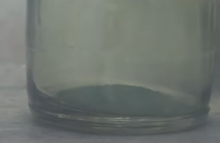
Back پلوتونیوم (IV) اوکسید AZB Diòxid de plutoni Catalan Oxid plutoničitý Czech Plutonium(IV)-oxid German Διοξείδιο του ποσειδωνίου Greek Dióxido de plutonio Spanish پلوتونیوم (IV) اکسید Persian Plutoniumdioksidi Finnish Dioxyde de plutonium French प्लूटोनियम(IV) ऑक्साइड Hindi

| |

| |
| Names | |
|---|---|
| IUPAC name
Plutonium(IV) oxide
| |
| Systematic IUPAC name
Plutonium(4+) oxide | |
| Other names
Plutonium dioxide
| |
| Identifiers | |
3D model (JSmol)
|
|
| ChemSpider | |
| ECHA InfoCard | 100.031.840 |
| EC Number |
|
PubChem CID
|
|
CompTox Dashboard (EPA)
|
|
| |
| |
| Properties | |
| O2Pu | |
| Molar mass | 276 g·mol−1 |
| Appearance | Dark yellow crystals |
| Density | 11.5 g cm−3 |
| Melting point | 2,744 °C (4,971 °F; 3,017 K) |
| Boiling point | 2,800 °C (5,070 °F; 3,070 K) |
| Structure | |
| Fluorite (cubic), cF12 | |
| Fm3m, No. 225 | |
a = 539.5 pm[1]
| |
| Tetrahedral (O2−); cubic (PuIV) | |
| Hazards | |
| Occupational safety and health (OHS/OSH): | |
Main hazards
|
Radioactive |
| NFPA 704 (fire diamond) | |
| Flash point | non-flammable |
| Related compounds | |
Other cations
|
Uranium(IV) oxide Neptunium(IV) oxide Americium(IV) oxide |
Except where otherwise noted, data are given for materials in their standard state (at 25 °C [77 °F], 100 kPa).
| |
Plutonium(IV) oxide, or plutonia, is a chemical compound with the formula PuO2. This high melting-point solid is a principal compound of plutonium. It can vary in color from yellow to olive green, depending on the particle size, temperature and method of production.[2]
- ^ Christine Guéneau; Alain Chartier; Paul Fossati; Laurent Van Brutzel; Philippe Martin (2020). "Thermodynamic and Thermophysical Properties of the Actinide Oxides". Comprehensive Nuclear Materials 2nd Ed. 7: 111–154. doi:10.1016/B978-0-12-803581-8.11786-2. ISBN 9780081028667.
- ^ "Nitric acid processing". Los Alamos Laboratory.
